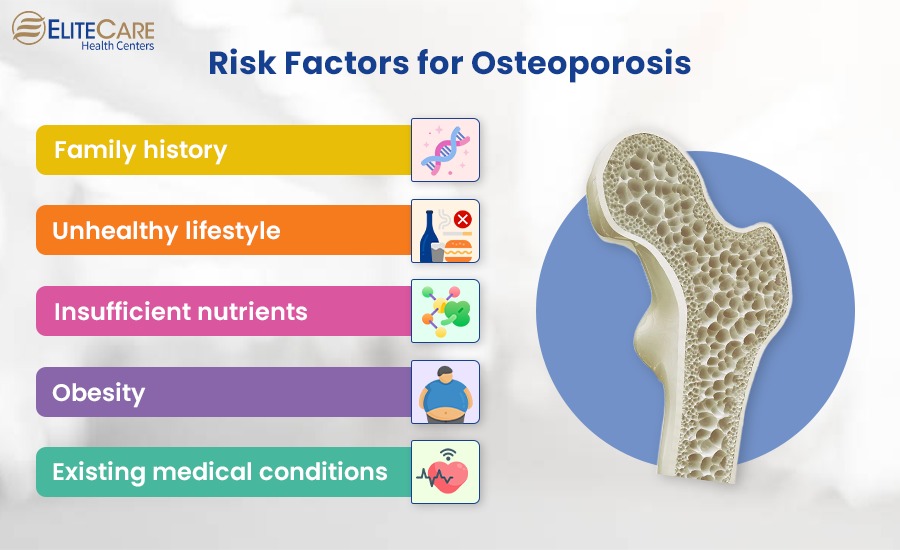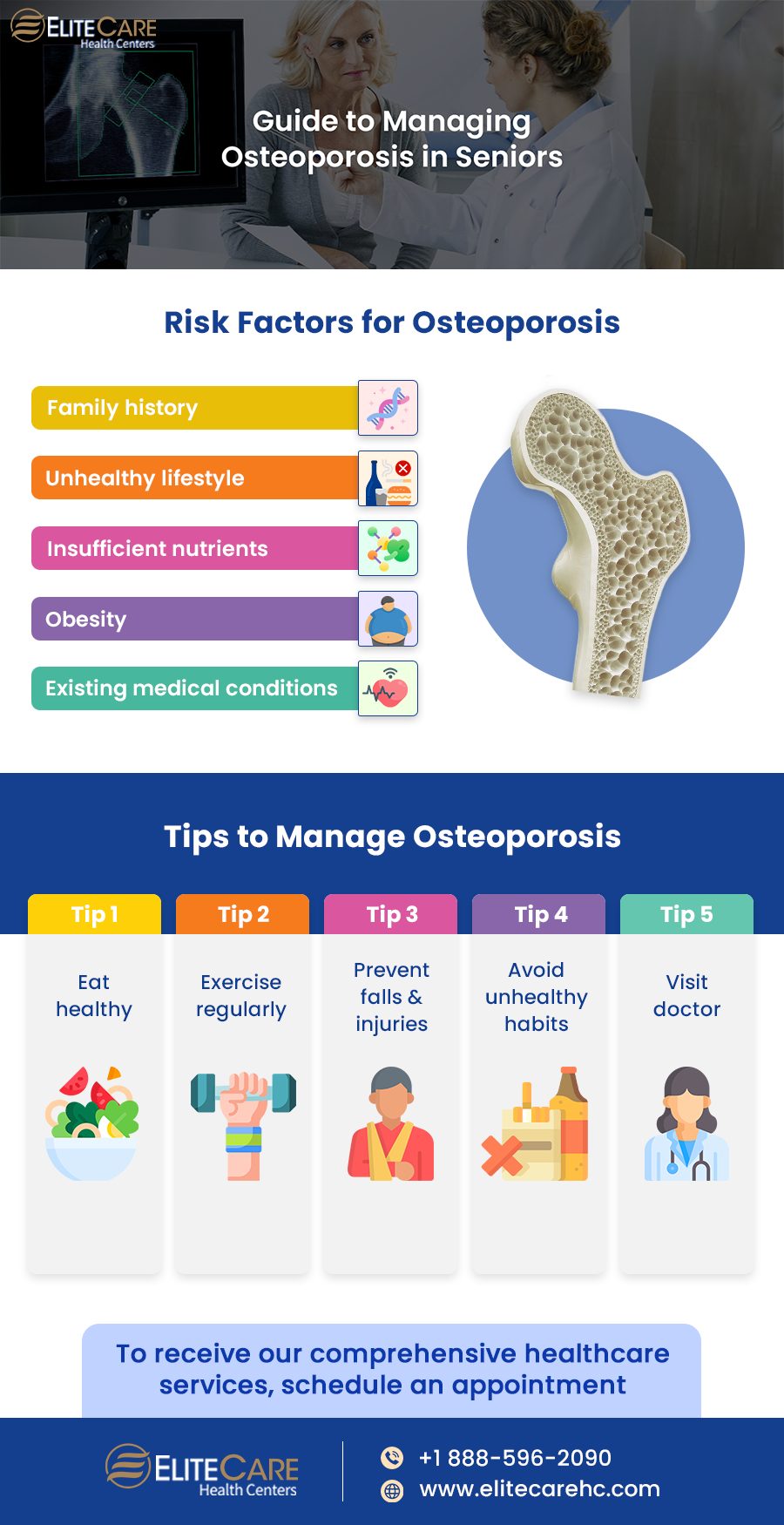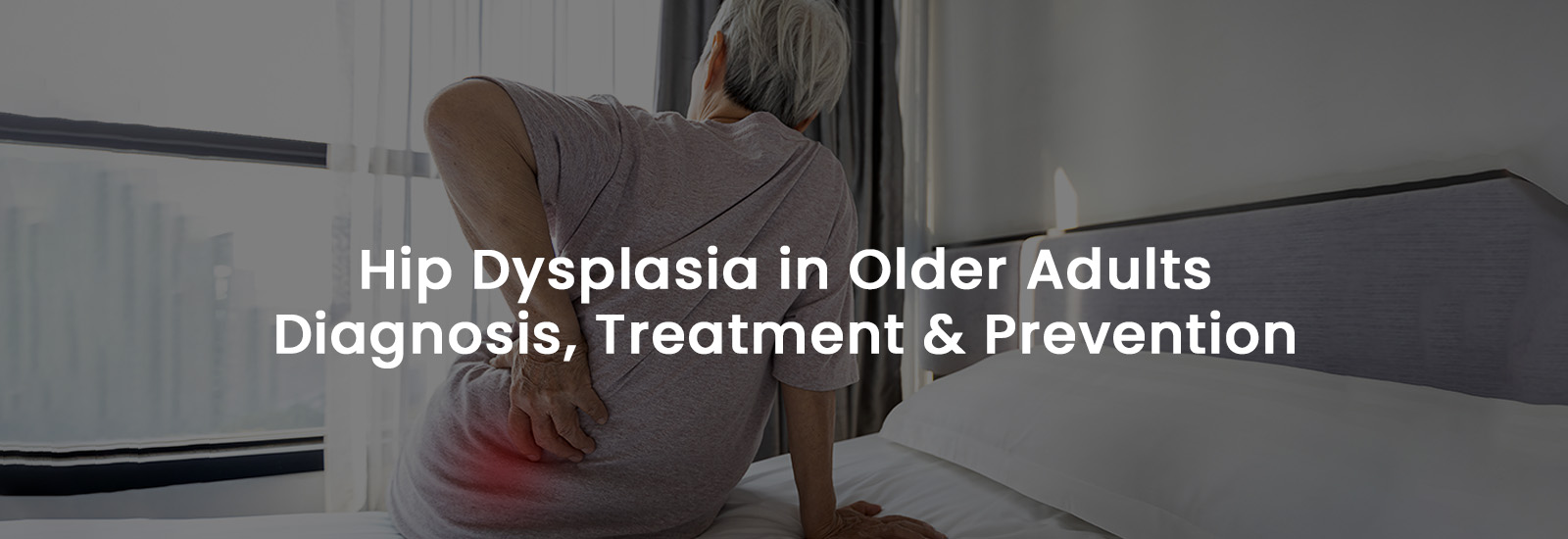
Signs of Osteoporosis in the Elderly
Although early, detectable symptoms of osteoporosis in seniors are rare, there are a few signs that can indicate potential bone loss.
- Receding gums
- Weaker hand grip strength
- Brittle fingernails
Most people fail to recognize weak bones until they have a fall and are diagnosed with a broken bone. If the bone mass has deteriorated further due to osteoporosis, seniors may start to experience symptoms including the following:
- Loss of height
- Back or neck pain
- Frequent fractures from falls
- Stooped posture
Risk Factors for Osteoporosis

- Family history: Osteoporosis is hereditary, and people whose parents or close relatives have osteoporosis are at a higher risk of developing the disease.
- Unhealthy lifestyle: Smoking and excessive alcohol intake can trigger hormonal changes and increase your risk of osteoporosis.
- Insufficient nutrients: One of the leading causes of osteoporosis is inadequate nutrition which can cause severe damage to the bones. Lack of calcium and vitamin D in your diet can significantly increase the risk of bone deterioration.
- Obesity: Being obese can put extra pressure on the bones, especially as you age, increasing the risk of injuries and fractures.
- Existing medical conditions: A few medical conditions like hyperthyroidism or hyperparathyroidism can put you at an increased risk of developing osteoporosis. Similarly, some medicines, such as corticosteroids can result in bone thinning if used for long periods.
Tips to Manage Osteoporosis in Seniors

While osteoporosis is not entirely preventable, it is manageable with a few lifestyle changes and stay-active tips. Here are six effective ways to manage osteoporosis in seniors.
1. Opt for a well-balanced diet
A well-balanced diet rich in protein, calcium, and vitamin D is the most effective way to protect your bones. Calcium is a crucial nutrient to add to your diet since it helps to maintain bone density and repair damaged bone tissues. In addition, the body needs vitamin D to absorb the calcium you consume through foods.
Here’s a list of a few calcium-rich foods to protect your bones.
- Broccoli
- Kale
- Mustard greens
- Turnip greens
- Almonds
- Brazil nuts
- Dried beans
- Salmon
- Shellfish
- Sardines
If there is any dietary restriction due to any additional health issues the seniors are suffering from, consult the primary care physician for prescription of calcium supplements.
2. Exercise regularly
Body muscles play the most critical role as a scaffolding for the bones. Regular exercise not only keeps your muscles strong but also helps in maintaining bone density. The most suitable physical activities for older adults to reduce the risk of osteoporosis are light-weight training, stretching, or aerobic exercise such as walking, swimming, and biking. But always make sure to consult with a doctor before starting a fitness regimen.
3. Maintain healthy weight
Researchers have found that people with a body mass index (BMI) of less than 18.5 or weighing less than 127 pounds are more likely to suffer osteoporosis-related fractures. Similarly, being obese can also put seniors at a much higher risk for osteoporosis as it creates more pressure on the bones. Hence, following a strict diet and maintaining a healthy weight is critical to managing osteoporosis in the elderly.
4. Protect yourself from falls and injuries
Falling and suffering a fracture is always a big risk factor for the elderly. Therefore, identifying and removing trip hazards and taking precautions can help avoid unfortunate accidents that can exacerbate their condition.
Here are a few ways to prevent falls and injuries at home:
- Remove slippery or loose rugs from the floor
- Ensure all electrical cords are tucked away
- Install a ramp instead of stairs at the home entrance
- Add safety rails and grab bars wherever required
- Choose a non-slip surface or mat for the bathroom floor
- Add enough lights for better sight
- Do not be in a hurry while getting up from or lying down on the bed
- Get a cane or other supporting aids to move around
Read More: 9 Ways to Prevent Falls in the Elderly
5. Avoid unhealthy habits
Smoking can disrupt essential hormone production and negatively affect bone cells. Therefore, it can significantly increase the risk of osteoporosis as you age. But quitting can help lower the risk as the effects of smoking on bone health are reversible.
Besides, studies have shown that while the occasional glass of wine can help strengthen the bones, excessive alcohol consumption does the opposite. Consume alcohol in a limited quantity to prevent bone deterioration.
6. Never skip doctor appointments
Being a ‘silent thief’, osteoporosis can often become severe in seniors because there are hardly any warning signs. However, if you see any signs, don’t delay visiting the doctor. Besides, older adults often suffer from multiple chronic diseases and take different medicines for the same. It is wise to speak to the doctor about any side effects resulting from long-term use of medications.
Key Takeaway
There are some medications and medical treatments like osteopathic manipulative therapy to reduce the effects of osteoporosis on a senior’s health and quality of life. Although there are no guaranteed ways to eliminate the possibility of osteoporosis, a few healthier lifestyle choices can be helpful to prevent or slow down the development of the disease. Always remember to check with a physician before making any drastic changes to the diet plan or taking any medication. For the best senior care services, contact EliteCare Health Centers and schedule an appointment with the best family doctors.






